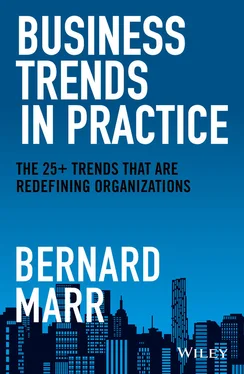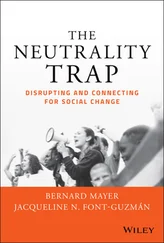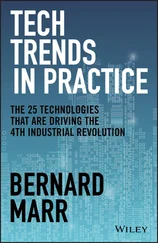I could write a whole book on the changes taking place in these sectors, so each chapter provides an overview and highlights some of the dramatic shifts taking place. And, of course, I wasn't able to include every possible sector or industry facing change. I wanted to highlight those sectors that touch all of our lives to ensure everyone can relate to them. Some sectors are deliberately not included here, because they're referred to so frequently across Parts IIIand IV. Retail is a prime example.
Bottom line, if your sector isn't explicitly mentioned in this Part, don't worry; many of the same challenges, trends, and transformations will be applicable to your organization, and there are many lessons to be learned from the changes taking place in these industries.
CHAPTER 3 HOW WE GENERATE ENERGY: The Three Trends Transforming the Energy Sector
Our traditional ways of generating energy are exploitative, unsustainable, and designed for the world of the past (making the name “fossil fuels” particularly apt). Then there's the problem that energy producers who are reliant on fossil fuels aren't held accountable for the true external costs, particularly the cost to the environment and people's health. Coal, for example, is only considered cheap because coal-fueled power stations don't have to pay for the environmental and social costs associated with burning coal. In some parts of the world, this will no doubt have contributed to the reliance on fossil fuels continuing far longer than it should have.
Now that we understand the impact of fossil fuels, it's time to start approaching energy production differently. And it couldn't be more urgent because some of the emerging alternatives being mooted have a long lead time, meaning we need to start investing in these technologies now if we're to reap the benefits by, say, 2050.
It's no exaggeration to say that I consider transforming the energy sector to be one of the most important challenges we face in the world. But there are exciting and encouraging signs of change. In particular, three key trends are promising to overhaul how we produce energy:
Decarbonization refers to the transition toward a clean, carbon-free world, largely by increasing the use of renewables. Increasing premiums on the use of fossil fuels would also fall under this.
Decentralization refers to distributed energy production, instead of the highly centralized grids that we're currently used to.
Digitization refers to the use of digital machines, devices, and technology to optimize energy production, infrastructure, and use. Think of it as “intelligent energy.”
Let's explore each trend in turn.
Trend 1: The Decarbonization of Energy
Electrification is often touted as a key way to decarbonize energy, with the move toward electric cars being a great example. The electrification of our world is such a key trend that, over time, electricity demand could increase by four times in Europe, while the price of electricity falls due to increasing use of renewables. 1 Unfortunately, at present, fossil fuels still make up a huge percentage of electricity generation in many parts of the world (in the US, for example, fossil fuels are responsible for 60.3 percent of electricity generation). 2 For electricity to become emissions-free, we must move further toward renewable energy solutions such as wind, solar, biofuels, and tidal power.
Switching to wind, solar, and water power worldwide could eliminate as many as 7 million deaths a year from air pollution, and slow (then, ultimately, reverse) the effects of global warming. 3 Roughly one-fifth of the world's primary energy supply already comes from renewable sources, and this is expected to continue growing by 2.6 percent each year until 2040. 4 Solar appears to be winning the market so far, making up 60 percent of the renewable energy capacity installed in 2019 and prompting technology giants like Apple and Google to invest in solar technology. 5
Looking beyond the well-known option of solar panels on roofs, some of the most exciting solar projects to make headlines in recent years include: 6
A floating solar farm in the Maldives, which aims to provide clean energy to 360 million people who live in remote coastal areas
A solar bike path in the Netherlands
A solar-powered train tunnel in Belgium
A solar-powered airport in India
Overcoming the challenges with renewable energy
The challenge with renewable solutions is that we need energy 24 hours a day, yet sometimes there's simply no wind or sun, a problem known as “intermittency.” What's more, peak demand times may not coincide with peak energy production times. This means we need to find ways to store the energy produced, so that energy captured can be transmitted and used later. Currently, there's no effective way to store the electricity produced by renewable technologies for any real length of time. But this is one area where exciting changes are happening, such as the Advanced Clean Energy Storage scheme in Utah, a hydrogen-based renewable energy storage complex. 7 Or there's Swiss startup Energy Vault, which is developing energy storage technology for intermittent renewable energy sources, inspired by pumped-storage plants that rely on the movement of water to generate power. Power-to-X – an umbrella term for processes that turn electricity into heat, hydrogen, or renewable synthetic fuels – may also play a role in solving the energy storage problem, and, in turn, accelerate the shift to renewables. 8 So, too might distributed power generation (more on that later in the chapter).
There's also the uncomfortable fact that electric vehicles, solar panels, and wind turbines are using rare earth materials mined from the earth. China has a monopoly on these materials (see Chapter 1), meaning geopolitical challenges could play an increasing role in the energy sector. 9
Investing in other energy alternatives
As well as investing in energy storage projects, we also need other clean energy alternatives – solutions that are able to generate a consistent, reliable supply of clean electricity when supply from renewable sources dips. For now, that means nuclear. I understand people's nervousness around nuclear power, but the technology is one of the safest and cleanest ways of producing energy. In the 60-year history of civil nuclear power, there have been three major accidents at power plants, with Fukushima Daiichi being the most recent in 2011 (imagine if the aviation industry had such a record), and, overall, nuclear energy results in 99.7 percent fewer deaths than coal and 97.5 percent fewer than gas (the safety record for wind and solar is even more impressive). 10 Modern nuclear reactors are much safer than the ones we build decades ago. Looking ahead, we also have nuclear fusion edging closer (see Chapter 2), with the world's largest nuclear fusion project beginning assembly in France. 11
We may also see advances in other alternative energy sources that could help to support wind and solar. These include: 12
Tidal power, captured from wave energy. Portugal established the world's first commercial-scale wave farm in 2008.
Space-based solar power, which has already been proven viable by the Japan Aerospace Exploration Agency.
Human power, where we generate power through our own bodies. For example, UK researchers have developed a knee brace that can produce electricity as the wearer walks.
Embeddable solar power, where potentially any window or sheet of glass can be turned into a photovoltaic solar cell. Researchers at Michigan State University are already working on scaling this technology.
Trend 2: The Decentralization of Energy
Читать дальше












